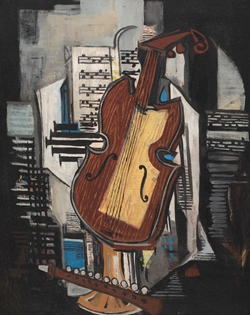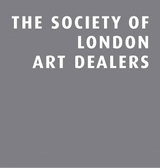Ismael De La Serna (1898 - 1968)
- AVAILABLE ARTWORKS FOR SALE
-
Ismael De La Serna (1898 - 1968)
Jeune Fille à l'Accordéon
Oil on masonite
88.9 x 115.6 cm (35 x 45 ¹/₂ inches)
Signed upper right, De La Serna and titled on the reverse
Executed circa 1942 -
Ismael De La Serna (1898 - 1968)
Still Life with Violin
Oil on canvas
81 x 65 cm (31 ⁷/₈ x 25 ⁵/₈ inches)
Signed lower centre, La Serna
Executed circa 1930
For more available works please contact us on stern@pissarro.com or +44 (0)20 7629 6662.
Born in Spain, Ismael González "de la" Serna studied at the Academy of Fine Arts in Granada, Spain. Whilst at school González befriended the famous poet Federico Garcia Lorca, whose first book, Impresiones y Paisajes was illustrated by González. This friendship proved to be crucial in navigating the direction of his work.
After visiting the French Impressionists exhibition in Madrid in 1917, González became more focused on developing a ‘free’ artistic style. This exhibition founded his notions of colour and line, and remained a consistent narrative throughout his oeuvre. In 1921, he moved to Paris, rarely returning to Spain. In Paris he was a member of the avant garde group, Spanish School of Paris. During this period he was influenced by the Cubist artists George Braque and fellow Spaniard, Pablo Picasso. It is claimed by the art critic Teriad, that Picasso declared “at last, a true painter! As grand as Juan Gris!”
González exhibited widely in the 1920s with much success. Paul Guillaume, a renowned Parisian art dealer of the Modigliani, Pablo Picasso and Henri Matisse, organised for an exhibition of fifty of his works. This lead to him exhibiting in the Musée du Jeu de Paume, Paris in 1936, the Spanish Pavilion at the Paris International Exhibition in 1937. Later an individual exhibition at the Gallery Flechtheim in Berlin, which was sold out. In his later years the was a retrospective at the Museum of Fine Arts in Mexico in 1956, which was soon followed by another retrospective at the Tate Gallery in London in 1963.
In 1964, he became wheelchair bound after a long battle with Cerebral palsy. From this point on, he very rarely ventured out of his home. After his death, the Museum of Modern Art in Paris held a retrospective exhibition in homage to this great artist.
Initially, González experimented with neoclassic forms, later moving to a more Cubist style. Although a Cubist painter, González’s paintings were unique as they revealed an affection for colour influenced by the French Impressionists such as Cézanne and Camille Pissarro.
In the 1950s, he drifted away from commercial conventions to search for ‘the essence and the ultimate goal of painting.’ He reduced an image to its bare essence a mere outline in which form approached the postulate of Abstraction.
Read more
After visiting the French Impressionists exhibition in Madrid in 1917, González became more focused on developing a ‘free’ artistic style. This exhibition founded his notions of colour and line, and remained a consistent narrative throughout his oeuvre. In 1921, he moved to Paris, rarely returning to Spain. In Paris he was a member of the avant garde group, Spanish School of Paris. During this period he was influenced by the Cubist artists George Braque and fellow Spaniard, Pablo Picasso. It is claimed by the art critic Teriad, that Picasso declared “at last, a true painter! As grand as Juan Gris!”
González exhibited widely in the 1920s with much success. Paul Guillaume, a renowned Parisian art dealer of the Modigliani, Pablo Picasso and Henri Matisse, organised for an exhibition of fifty of his works. This lead to him exhibiting in the Musée du Jeu de Paume, Paris in 1936, the Spanish Pavilion at the Paris International Exhibition in 1937. Later an individual exhibition at the Gallery Flechtheim in Berlin, which was sold out. In his later years the was a retrospective at the Museum of Fine Arts in Mexico in 1956, which was soon followed by another retrospective at the Tate Gallery in London in 1963.
In 1964, he became wheelchair bound after a long battle with Cerebral palsy. From this point on, he very rarely ventured out of his home. After his death, the Museum of Modern Art in Paris held a retrospective exhibition in homage to this great artist.
Initially, González experimented with neoclassic forms, later moving to a more Cubist style. Although a Cubist painter, González’s paintings were unique as they revealed an affection for colour influenced by the French Impressionists such as Cézanne and Camille Pissarro.
In the 1950s, he drifted away from commercial conventions to search for ‘the essence and the ultimate goal of painting.’ He reduced an image to its bare essence a mere outline in which form approached the postulate of Abstraction.



